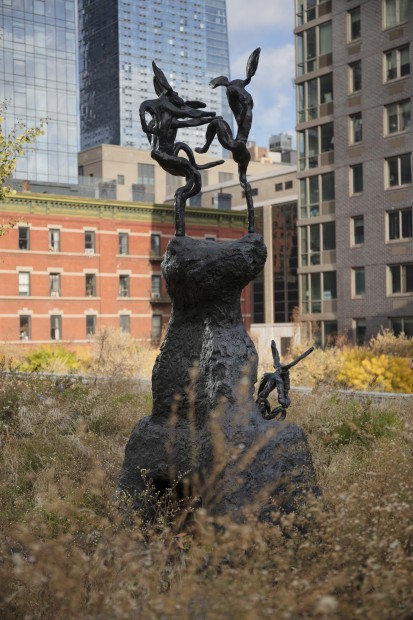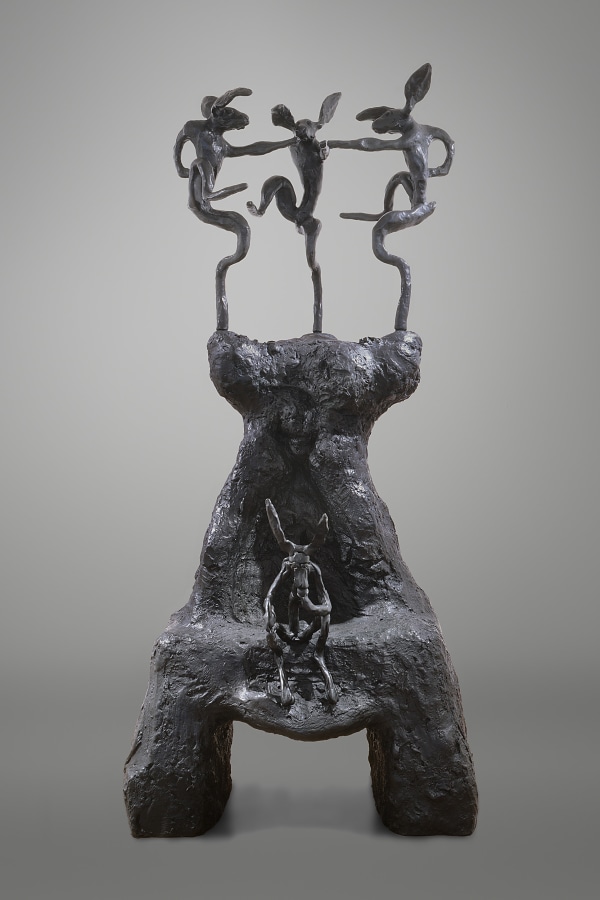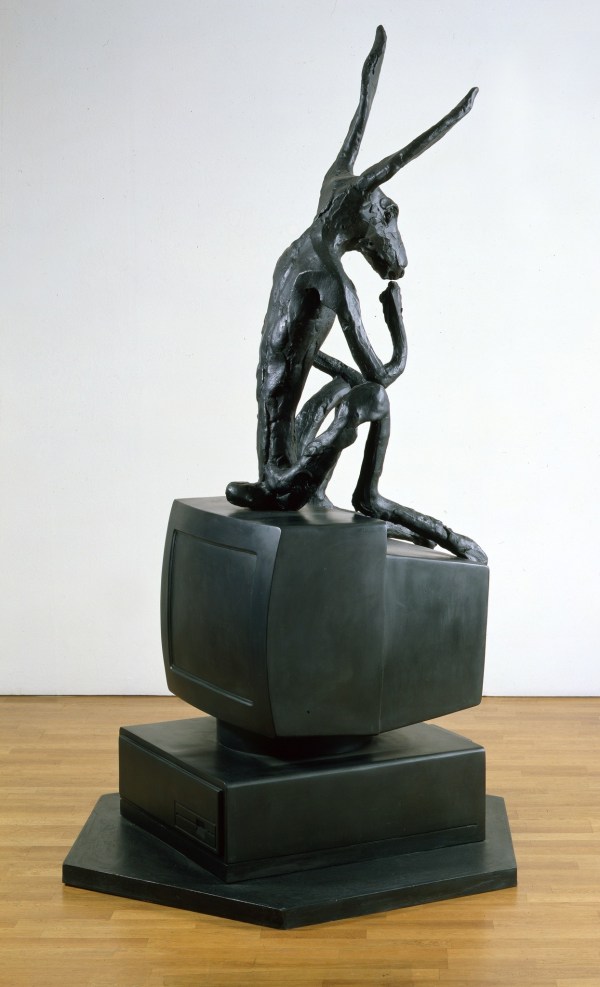Barry Flanagan
-
-
Kasmin Sculpture Garden presents an exhibition of two large-scale bronze sculptures by Welsh sculptor Barry Flanagan (1941–2009). Representing significant examples of the artist’s later work featuring his signature motif of the hare, the works are situated on the roof of the gallery’s 509 West 27th Street space and on view from The High Line at 28th Street.
-
In the late 1970s, Flanagan began to distill his decades-long fascination with ontology, movement, and materiality into the figure of the hare. He was fascinated by the animal’s anthropomorphic potential—its ability to magnify a range of expressive attributes and to convey meaning and feeling beyond what he felt was possible in the manifestation of human form. The artist’s immersion in the country pursuits of gamekeeping and poaching, as well as the publication of George Ewart Evans' ‘The Leaping Hare’ in 1972, cemented the artist’s engagement with the animal’s mythological and Pataphysical iconography. After witnessing the animal dash across the Sussex Downs, Flanagan was struck by its mysterious, acrobatic, unpredictable movements as set against the backdrop of an untamed wilderness.
-

-
Flanagan's enduring wit and engagement with the work of August Rodin is exemplified in Larger Thinker on Computer (2003), which depicts a hare sitting on top of a desktop computer screen in the pose of The Thinker. As well as humorously drawing upon the composition of the work, Flanagan elaborates on the dynamic potential of bronze first radically proposed by the French sculptor in the early 20th Century.
Large Monument, 1996, similarly draws on the work of Rodin, this time in a homage to the monumental Gates of Hell (1880–1971). Jo Melvin, Director of the Estate of Barry Flanagan, says of the sculpture: “It has a material and visceral quality that responds to Rodin’s handling and uses a tactile sensibility to create an inventive transformation of his composition. Flanagan uses three different methods to model the components. Rodin’s angst-ridden Three Shades become three virile dancing Nijinski hares, modelled in clay and using Rodin’s own triumphant subject of the celebrated dancer as a refutation in the face of the gates of hell. The thinker is made with modelling resin and is muscular like Rodin’s Thinker, but in Flanagan’s hare the limbs are indicative, tense equivalents of musculature with the resin slabs wrapped round the armature. The gate is a potent mass of material, showing the chiselled and hacked marks of its making and its scale makes the confrontation with physicality inevitable.”
-

-
The exhibition continues Kasmin’s ongoing commitment to bringing Flanagan’s work to the public in New York, beginning with the installation of Large Left-Handed Drummer in Union Square (2007) and a solo presentation of the artist’s bronze hares at ADAA The Art Show held in the Park Avenue Armory (2009). Examples of Flanagan’s iconic hare works are included in important public collections such as Hirshhorn Museum and Sculpture Garden, Washington, D.C.; Museum of Modern Art, New York; Peggy Guggenheim Collection, Venice, Italy; San Francisco Museum of Modern Art, San Francisco, CA; Tel Aviv Museum of Art, Tel Aviv Yafo, Israel; and Tate, London, United Kingdom.
-
Works
-
About the Artist

-
Join our Newsletter
* denotes required fields
We will process the personal data you have supplied in accordance with our privacy policy (available on request). You can unsubscribe or change your preferences at any time by clicking the link in our emails.
-
Explore
-
Explore
- Diana Al-Hadid
- Alma Allen
- Theodora Allen
- Sara Anstis
- Ali Banisadr
- Tina Barney
- Judith Bernstein
- JB Blunk
- Mattia Bonetti
- William N. Copley
- Cynthia Daignault
- Ian Davenport
- Max Ernst
- Liam Everett
- Leonor Fini
- Barry Flanagan
- Walton Ford
- Jane Freilicher
- vanessa german
- Daniel Gordon
- Alexander Harrison
- Elliott Hundley
- Robert Indiana
- Lee Krasner
- Les Lalanne
- Matvey Levenstein
- Lyn Liu
- Robert Motherwell
- Jamie Nares
- Nengi Omuku
- Robert Polidori
- Jackson Pollock
- Elliott Puckette
- Alexis Ralaivao
- George Rickey
- James Rosenquist
- Mark Ryden
- Jan-Ole Schiemann
- Joel Shapiro
- Bosco Sodi
- Dorothea Tanning
- Naama Tsabar
- Bernar Venet






